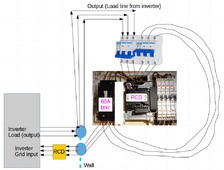Hedges
I See Electromagnetic Fields!
- Joined
- Mar 28, 2020
- Messages
- 21,510
Those terminal blocks are meant for low voltage, not exposed hazardous voltages.
You can find set-screw types that accept your wire gauge, and have a cover.
US code says not to put two wires into one terminal that isn't rated for it.
I'd be tempted to strip 1" of insulation off the middle of a wire, fold it in half, twist, and insert in Breaker (RCD) terminals.
Viola! A "V" (use similar to "Y") connection.
I also use multi-port set-screw connectors (Polaris), or split-bolts wrapped in rubber tape then vinyl tape.
You can find set-screw types that accept your wire gauge, and have a cover.
US code says not to put two wires into one terminal that isn't rated for it.
I'd be tempted to strip 1" of insulation off the middle of a wire, fold it in half, twist, and insert in Breaker (RCD) terminals.
Viola! A "V" (use similar to "Y") connection.
I also use multi-port set-screw connectors (Polaris), or split-bolts wrapped in rubber tape then vinyl tape.





